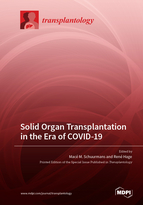COVID-Related Chronic Allograft Dysfunction in Lung Transplant Recipients: Long-Term Follow-up Results from Infections Occurring in the Pre-vaccination Era
Round 1
Reviewer 1 Report
Thank you for sharing the article from Hagea et coll. entitled "COVID-related....pre-vaccination era."
The article is a monocentric retrospective study from switzerland, questionning the impact of COVID 19 infcetion on lung function. The article is clearly written. English should be review by a native speaking reviewer. I have some major and minor comments.
Major comments:
- The question is interesting , however, as the autor noted in discussion the small study populaiton does not allow strong conclusion.
- For this reason, precisions are needed in order to get some information.
- About methodology: 1/We clearly mis a table with study population description including very classical data when adressing CLAD, such as: delay post transplantation/Pre-exixting CLAD level/previous ACR or DSA/ GERD/ongoing IS regimen...; 2/ with such a smallpopulation it may notbeinteresting to split the population in 3 groups based on severity of COVID at the acute phase, which can be reported as one of the data in the study population table (if the aim is to show that there is a correlation between acute severity and further loss in lung function, the present tables are not very conclusive); 3/ individual result of FEV1 are difficult to read;it would be more informative to report that ...% had a loss of 10% FEV1/...% 5-10%; ....at 3, 6 and 12 months post COVID, for example (and test for correlation with initial caracteristics. 4/ at last in order to asses the proper role of COVID in Lung function loss, did the autor consider to match there patients with a COVID negative study population during the same period? if it is considered to complicated (despite more reliable), efforts should be made to provide an anaysis of the mecanisms of lung function loss in the failing patients: did they had TBB? ACR? de novo DSA/AHR? bacterial/fungal co-infection? other types of injury? Thrombo-embolic disease?
- About the message: the article suggests that COVID 19 may have a strong impact on further lung function. Wid had pretty different results in patients in our centers,and despite major pandemics, few autors reported this. Effirts should be make to better describe the failing patients for COVID: did they had persistent CT infiltrates? prolonged viral shedding? Other articles adressing prognosis could be added to references (Heldman AJT 2021; DOI: 10.1111/ajt.16692; Mohanka JHLT 2021, https://doi.org/10.1016/j.healun.2021.05.003= same autors as ref 17). Despite initial severe disease, very late improvemment have been described in COVID, which may not be the same as other CARV.
- Discussion should be rewritted. A lot of informations are given without references. Finally, the mecanism of lung fucntion loss and comparision with others CARV is missing.
Minor comments:
- About methodology : 1/Some frequent missing data for FEV1 at month 12. Could the autor ensure for exhaustivity? 2/ did all the patient underwent initial CT scan? if not autors should reconsider their classification of patients as mil/moderate/severe and base it only on oxygen requirement levels, for example.
- line 162: this is not an article on acute severity;not possible to suggest any conclusions with only 2 patients. Please delete this paragraph.
Author Response
Please see attached document
Author Response File: ![]() Author Response.docx
Author Response.docx
Reviewer 2 Report
Dear author’s
I was pleased to review your manuscript “COVID-related chronic allograft dysfunction in lung transplant recipients: Long-term follow-up results from infections occurring in the pre-vaccination era“ The topic is interesting.
However, the manuscript should be further improved. In order to improve the manuscript a have the following comments.
Methods: The sample of the study is relatively small.
Discussion - in this section is mandatory to compare your case with the literature.
What new information brings your article in the literature?
- Please modify the references accordingly.
- Other points:
- Punctuations and English reviews are necessary;
Author Response
Please see attached document
Author Response File: ![]() Author Response.docx
Author Response.docx
Reviewer 3 Report
1. Authors Hage and Schuurmans, in this article titled “COVID-related chronic allograft dysfunction in lung transplant recipients: Long-term follow-up results from infections occurring in the pre-vaccination era”, despite the global medical relevance of the pandemic, present no new information. Even the title of the paper does not reflect the information presented within the paper.
2. In fact, this paper is a matter of concern as it is a spin-off of an already published work by the same authors in the same journal, a year back (https://www.mdpi.com/2673-3943/2/2/22/htm). This sort of repetitive churning of data is completely unacceptable.
3. Agreed, that the authors present some relevant data on the FEV trajectories and relevance to CLAD-BOS, this information was already relevant for their first paper. Why didn’t the authors include this data in their previous paper as it was the same 18 patients and within the identical time frame. If at all, the two authors aimed at presenting only the FEV data in the current paper, it does not attempt to inform the reader about the continuity of their work, is very poorly written and is very rudimentary as far as just presenting FEV measurements as the only basal estimations for determining CLAD in the said patients. For example, why only the FEV measurements and not the forced expiratory flow rates at 25-75%?
4. The introduction requires to be crisper, have clarity, devoid of random sentences (example, line 69). The discussion has all but 4 lines (lines 161-164) that is somewhat related to the data whereas remaining of it seems rather irrelevant and taken from their previous work. The authors are urged to focus more on quality rather than quantity of papers.
Author Response
Please see attached document
Author Response File: ![]() Author Response.docx
Author Response.docx
Round 2
Reviewer 3 Report
Please see attached comments
Comments for author File: ![]() Comments.docx
Comments.docx
Author Response
Please see attachment
Author Response File: ![]() Author Response.docx
Author Response.docx







